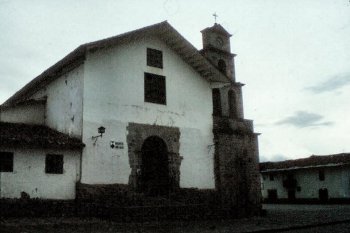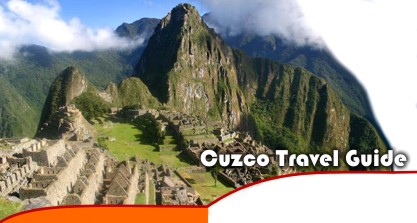 San Blas is today a
downtown neighborhood in the city known as the " Artists'
District", with narrow and writhing streets, most of them
steep. In Inkan times it was one of the most important
districts of Qosqo and its name was "T'oqo-kachi" (T'oqo =
hollow; kachi = salt). Like the other districts it was
inhabited by the Quechua nobility. It seems that the church
was erected over an Inkan Sanctuary devoted to cult of the "Illapa"
god (Thunder, Lightning and Thunderbolt). It was possibly
opened for the first time in 1544 by the city's second
Bishop Juan Solano. Although some other versions say that it
was after 1559 as consequence of viceroy Andres Hurtado de
Mendoza's order by which "Indians" had to built churches for
their indoctrination in the districts where they lived. Its
structure was simple with a rectangular floor plan and mud
brick walls, but after the earthquakes in 1650 and 1950 it
was partially reinforced with stone walls. It has just one
nave and two gates before which there are big plazas; and a
stone bell tower constructed after the 1950 earthquake
instead of the original made with mud bricks.
Inside the church is one
of the greatest jewels of colonial art in the continent: the
Pulpit of Saint Blaise; which is a filigree made in cedar
wood by expert hands managing a gouge. It is not known with
certainty who was the artist or artists that made it, how
long the work lasted, neither any other details about it.
However, the pulpit is over there as a mute witness of a
great Catholic devotion and devoted work. There are enough
proofs to assert that it was made carved with funds given by
art protector Bishop Manuel Mollinedo y Angulo; therefore,
it was by the end of the XVII century. There are serious
discrepancies about the identity of the performing artist.
Most authors suggest that
it was made by the most famous Quechua woodcarver: Juan
Tomas Tuyro Tupaq, that was contemporary and protected of
Mollinedo y Angulo, who entrusted him the manufacture of
several works. It also could have been work of some other
artists contemporary with Mollinedo such as Martin de
Torres, Diego Martinez de Oviedo who made the monumental
High Altar of the Compaņia de Jesus Church, or the
Franciscan Luis Montes that made the San Francisco Church's
choir. Oral tradition has its version gathered by Angel
Carreņo who in his "Cusquenian Traditions" manuscript had
stated in writing the name Esteban Orcasitas as the pulpit's
author; but, for the 1st. edition of his book the name was
changed by that of Juan Tomas Tuyrutupa. Tuyrutupa was
Quechua and Cusquenian, but according to that traditional
version he was a leper woodcarver from Huamanga (Ayacucho).
The story tells that once he had in his dreams a revelation
of the "Holy Virgin of the Good Happening" who told him that
if he wanted to get healed from his leprosy he had to look
for her in the small plaza of Arrayanpata in Qosqo City.
After a long journey and many mishaps, one day he found her
painted on a wall after that the roofing of the "Lirpuy-Phaqcha"
chapel fell in. Falling on his knees and weeping he invoked
her, as the Virgin's rosary became rose petals with which he
rubbed hard his whole body remaining thus completely healed.
The piece of wall containing the painting was cut and moved
to the Saint Blaise Church, then people agreed upon to build
an altarpiece and a pulpit for the Virgin. The grateful
Quechua woodcarver committed himself to make the pulpit
without charging any money for the work estimated in 1400
pesos. The work took him 4 years of hard labor with wood
from an enormous cedar tree that was cut in the Kusipata
square (present-day Regocijo). But, when finishing his work
the woodcarver failed his oath as he asked the church's
curate for 70 pesos in order to lionize a Cusquenian half-breed
woman. After fastening the Saint Paul statue over the
pulpit's sounding board, he stumbled and fell off dying soon
after. His corpse was buried under the pulpit but some time
later it was taken out and his skull placed before the feet
of the Saint Paul sculpture, where it is seen today. |
